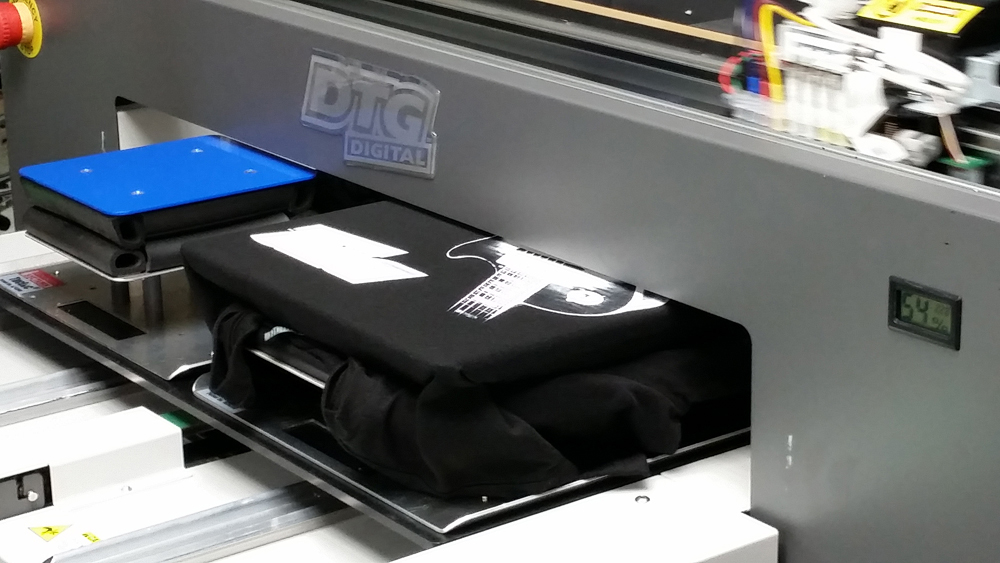Introduction
Both UV printers and DTG(Direct to Garment) printers can be used to print stickers on T-shirts. They share a lot of similarities. For example, as for the type of printing machines, both are inkjet printers. Moreover, their price range is pretty similar. The biggest difference between these two machines may be the
So many customers are confused with these two kinds of machines. Is one better than another? What criteria can be used to choose which kind of machines can better suit his need?
Details

The similarities between these two machines
Machine model: Both UV printers for T-shirts and DTG printers are inkjet printers. They are a type of automatic printing machines that use print head to directly print ink on the substrate of T-shirts. The item being printed is positioned on a bed that either transit under the scanning print head gantry or is traversed by the print head gantry. Smaller format UV printers and DTG printers transit the material under the head as opposed to moving the head over the material. And they are mainly considered flatbed UV printers. This means that they have a limited print area and work with specific materials that are loaded onto the bed – not fed by a roll like large format sign and sublimation printers.
Software: The software used in these two machines is almost the same. These two machines use RIP software which can help to separate layers, manage the color systems, increase resolution rate and improve the printing quality and other important functions. Many of these RIPs also calculate ink costs as well as allow for barcode automation and printed image archiving.
Working with white ink: The choice of white ink is to help printers able to print on substrates that are not white and maintain color integrity. This is in contrast to a sublimation process, for example, that requires you to print one or apply the result to a light-colored or white material. The use of white ink is important as both DTG and flatbed UV printers are most frequently printing on to finished products – whether garments for the DTG or cell phone cases, tiles, pens … etc. for the flatbed UV printers.
Difference between the UV printers for T-shirt and DTG printer
Print depth: The lowest position from the print head to the flatbed bed of most DTG printers only has a few inches, which limits the depth of items you can print on to about 2 inches. But 2 inches can also print on many textile T-shirts, jackets, canvas bags, canvas for photos.
With a UV printer, depths range from about 3 inches up to almost afoot. For example, the depth range of TUHUI 6090 UV printers have a 2.75 inches depth, so can print golf balls, etc. TUHUI UV Printer series can handle printing a basketball with its 11.8” depth.
Ink choice: UV printers use ultraviolet light to cure the inks on the substrate instantly. DTG printers adopt water-based ink so the inks are wet and need to be dried with a heat press, tunnel, or box dryer. And if you touch it, or fold the fabric accidentally before it’s cured you have ruined the garment.
The advantages of UV 6090 printers
According to our surveys, UV printers are occupying a bigger market. So we will mainly talk about UV printers for a T-shirt. Through the comparison, we may wonder why UV printers are taking up a bigger share in the market. The reason is mainly attributed to its benefits or advantages over DTG printers. Take the 6090UV printer as an example. The advantages of UV 6090 printers are as follows.
Multi-functional machines: The printer is equipped with a Japan Epson UV print head. It can be used in printable bottles, mobile phone cases, acrylic, wood panels, etc.
Rotary holder: The machine is equipped with a cylindrical fixture so that it can print the cylinder and adjust spacing. The printer can not only be used to print perfectly cylindrical objects but it can also be used to print items that simply have cylindrical features. Some of the products that can be used in the cylindrical printing process include beer bottles, candle holders, measuring cups, makeup containers, tubes, and so on.
3D embossed effect: You can prepare a blank ceramic stature or any flat and roll material that can be printed, and start the machine. After processing, you will get an embossed artwork. The embossed surface can give us a sense of reality and it makes the work more exquisite.
CMYK+WV six-color configuration: CMYK white and varnish are optional for glossy surfaces and high-quality printing. The colors are more vivid and the visual effects are more striking.
Flatbed UV Printers and DTG Printers – Digital Cousins
So, there you have it. The similarities and differences between DTG and UV printers. What is nice about them is that while they perform very different duties in the printing world, they are surprisingly similar in the way they operate and the software they use. This makes it very easy to add one once you have the other – the learning curve is shortened. And therein lies the real benefit and the greatest opportunity.

